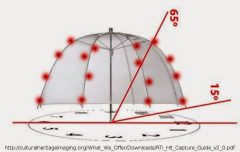Scott Coleman is a PhD candidate in the Department of History

Concept diagram for how RTI works, via Cultural Heritage Imaging, culturalheritageimaging.org
For my first Xlab post, I will discuss how I came to be part of this extraordinary group of scholars seeking to push the boundaries of digital scholarship. I first joined the Xlab team in the fall of 2021. I intended to perform network analysis on rural middle-Byzantine fortified settlements on the north-central and eastern Anatolian plateau utilizing new-to-me digital resources. An invitation to perform numismatic research in Athens, Greece, redirected my digital focus and brought an old technological fling back into my life. Reflective Transformation Imaging (RTI). Let me quickly explain.
Though my MA focused on Byzantine settlement identity, numismatics, the study of coins, is my scholarly passion. Byzantine coins played a significant role in my MA research. However, the pandemic forced me to rethink how to perform numismatic research when physical access to coins was no longer possible. As restrictions were gradually lifted, I started a numismatics practicum at the Nickle Galleries (the University of Calgary) and was introduced to RTI. I immediately saw the software’s potential for numismatic imaging and creating a more accessible and interactive resource for scholars and the public.
Reflective Transformation Imaging, also known as Polynomial Texture Mapping, was developed in the early 2000s by Tom Malzbender and Dan Gelb of Hewlett-Packard Labs (Hageneuer, 2021). The basic premise of RTI is to capture photos of an object (the number of images depends on the object being imaged) with a camera (preferably a DSLR) from a fixed position while moving the light source for each photo taken and blending these images with RTI software. The final product is an interactive image that simulates light reflection and shadows, which allows tiny details the naked eye cannot see to be highlighted and viewable via shadow manipulation. Cool stuff, eh? Unfortunately, the technology has not been updated for some time and is difficult to work with. If you are interested in my struggles using RTI on a Mac computer, visit my blog post (shameless plug) at www.roguehistory.ca
So, the question becomes, why am I so interested in this older tech for Xlab?
First, I was increasingly frustrated with how coins were stored and locked in vaults. Admittance restrictions, travel costs, or a lack of resources have limited access to thousands of these artifacts and made it exceedingly difficult to do research. And it is even more difficult for the public to engage with ancient coins and be enchanted by their materiality. Their history. Their narratives. My objective in Xlab is to push the limits of RTI and create 3D images of ancient coins with RTI layered onto the image with the eventual goal of creating a more inclusive and accessible numismatic collections database.
A museum can only display so many coins for public consumption, which is generally a “no touchy” policy. Thus, not all coins can be seen or interacted with. That is not fun. Coins are meant to be handled, felt, and looked at – closely – and museums, understandably, do not make this easy. RTI, layered onto 3D imaging, and exhibited on open-access platforms, can eliminate the need for expensive travel to access collections for research. More importantly, RTI can allow the public to have a level of interaction, engagement, and enchantment with ancient coins that is not available to them through standard display-case exhibitions. Now, my Ph.D. focus is on the curation, presentation, and representation of Byzantine identity via Byzantine coins for public consumption and with the support of Xlab, I hope to make these goals a reality…so stay tuned.